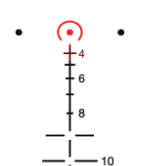Reticle is an integral and one of the most basic and important components of a telescopic rifle sight.
Since the invention of scopes in the 1830s, their overall design including that of the reticle has changed over the years. So much so that there are a lot of reticle options to choose from these days.
Dive into the world of rifle scope reticles and fill your minds with some basic and also exclusive knowledge on this topic.

Reticle Terminology and Common Concepts
Enlighten yourself with some common techie-jargon used when talking about rifle scopes and reticles. So you get a better understanding when reading further.
Crosshairs
In simplest terms, crosshairs refer to the vertical and horizontal lines that intersect to form a ‘plus’ sign. Traditionally, crosshairs were made of two thin wires (sometimes called ‘stadia lines’). The crosshairs are the reference point for aiming at a target when looking through a scope.
Reticle
Reticle is a term used to address advanced crosshairs. Reticles can either be physical or etched on a glass inside a scope. A reticle can be simple or complex in design. Allowing the shooter to infer different physical values.
Focal Planes
Focal planes refer to the plane through the focus, perpendicular to the axis of the lens. If that went over your head, just understand that the focal plane is the region where you can view an object when looking through a lens.
FFP and SFP
FFP stands for First or Front Focal Plane. In FFP rifle scopes, the reticle is placed ahead of the magnifying assembly. Hence the size of the reticle changes with the magnification. The benefit being that your adjustments stay true regardless of what magnification you are working at for a target.

SFP vs FFP: Courtesy of OpticsBible.com
SFP stands for Second Focal Plane. In this scope, the reticle is placed behind the magnifying assembly, and the size of the reticle stays constant across all magnification levels. So adjustments have to be changed at every zoom level.
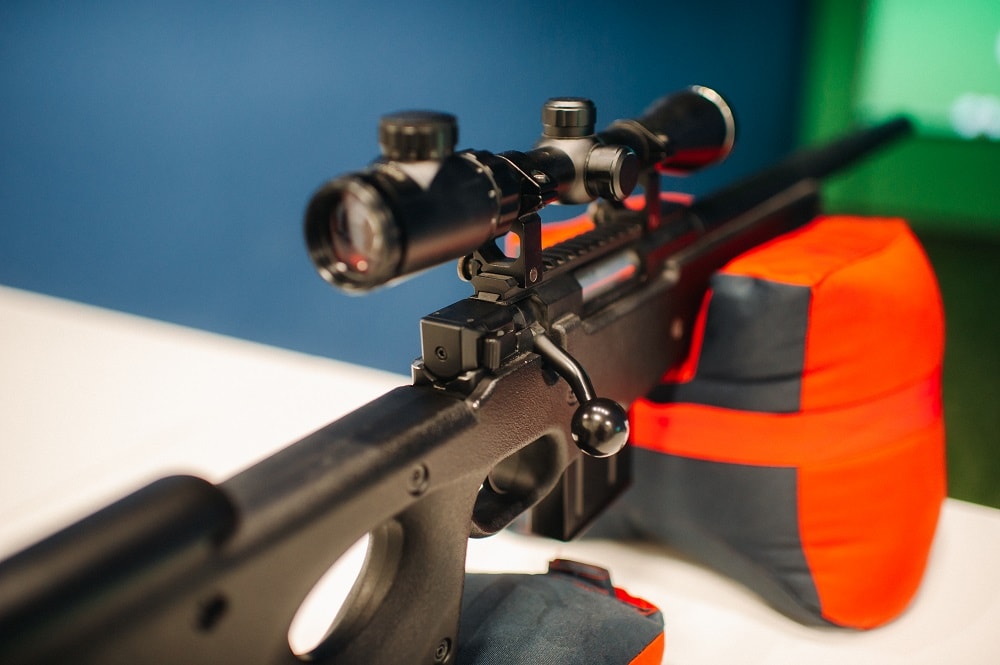
Degree of Measurement (MOA or Mrad)
MOA stands for Minute of Angle and represents one degree in a 360-degree circle. It denotes a one-inch area at 100 yards. Mil Radians or Mrad is another measurement used mostly by the military and translates to a covered area of 3.6 inches at 100 yards.
Subtension
Subtension refers to the area covered by a reticle on a target at a specific magnification and distance (commonly 100 yards). Subtension is only valid at the highest magnification for SFP scopes. Whereas in FFP, subtension remains constant.
Turret Adjustments (Windage, Elevation & Parallax)
Windage refers to the horizontal shift and elevation is the vertical shift in the trajectory of a bullet. Windage is affected by wind or a moving target and elevation by gravity. Every scope has knobs to compensate for these values. Parallax refers to the stability of an image when moving your head around while viewing it.
Holdover
The points on the vertical line (elevation) of the reticle where you put the target’s desired point to impact.
Diopter Adjustment
A small focus knob near the scope’s eyepiece allows you to bring the reticle into focus for proper viewing.
Types of Reticles
The most basic bifurcation in the design of reticles are crosshairs and dot reticles. While crosshairs have been around since the inception of scopes. Dots are also a revolutionary concept, particularly useful for quick adjustments and close range uses.
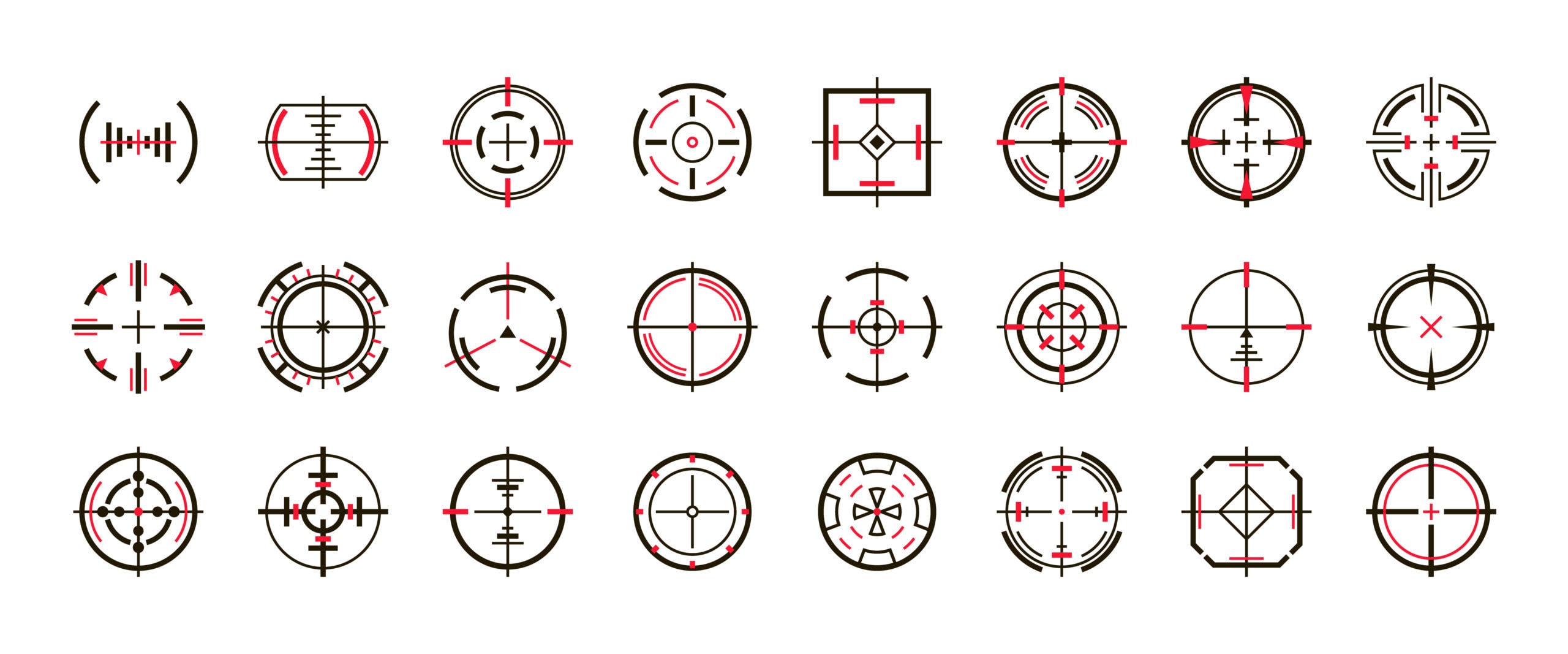
Crosshair Reticles
Crosshairs can be physically intertwined wire setup or they may be etched on the glass. Let’s look at some crosshair reticle variations.
Duplex Reticle
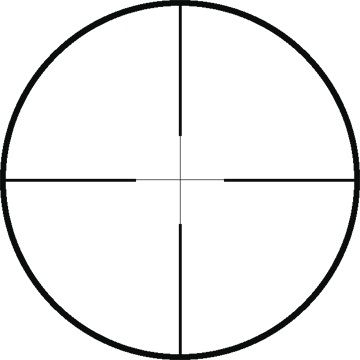
This is the most common type of reticle you will find on hunting rifle scopes. Either in its basic or slightly modulated form. It consists of four thick lines that converge to meet on the center of the axis. With the lines being thinner near the axis. The thick lines provide easily visible reference even on a color-cluttered background.
Whereas the thin lines on the center ensure that the estimated point of impact is not overshadowed by the image of the reticle.
Duplex reticle is great for short range hunting where you don’t have to worry about turret adjustments. The thin center is the characteristic feature of this reticle. There’s also a fine duplex reticle with thinner outer lines.
German Reticle
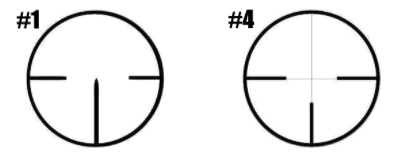
German Reticle #1 vs #4
With its invention dating back to the times of World War I. The German reticle features three thick lines on the 3, 6, and 9 O’clock positions. While the top doesn’t have a line. The most common variations are the German #1 and German #4 (with a thin top line) reticles.
This reticle was extensively used by German and Russian snipers until WWII. The thick lines help with quickly centering the target. But, elevation and windage adjustments are a slight problem due to the density of the crosshairs.
The German #4 reticle has variants that are suited for adjustments due to the extended thin stadia lines.
Christmas Tree Reticle
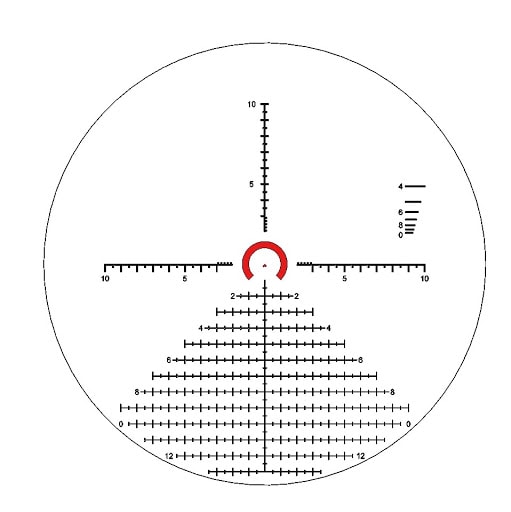
Photo credit: larsonweb.com
The Christmas Tree Reticle features a grid system that provides holdover reference points for quick estimation of windage and elevation values. Without the need to adjust the turrets. The horizontal grid lines extend in length as they move lower. So the grid looks like a pine tree. Hence the name.
Colloquially, it can be seen as a more advanced version of the Duplex reticle. The Christmas Tree Reticle is very popular among competitive shooters and tactical snipers due to the quick reference markings that help adapt to change. Additionally, it is somewhat an overloaded design for hunting.
Mil-Dot Reticle

Mil-Dot / MRAD Reticle: Coutesy of Trijicon.com
The basic pattern imitates that of a duplex reticle and features four or sometimes more dots on the thin area of the converging crosshairs. Each dot on the reticle represents one mil-rad or 3.6 inches at 100 yards or 36 inches at 1,000 yards.
These dots are spaced at 1 milliradian each and work as reference points when you have to adjust for windage or elevation changes.
This reticle is preferred by snipers and extreme long range target shooters.
MRAD Reticle
Same as the above reticle. Mil-dot and MRAD are colloquial terms used for the same thing. These reticles use milliradians as the degree of measurement. Which translates to 3.6 inches of subtension at 100 yards.
MRAD reticles can be found in a variety of design features. Being an MRAD reticle just denotes the degree of measurement for the dots or lines on the reticle.
BDC Reticle
An all-time favorite of long-distance shooters on a calm non-windy day. BDC stands for Bullet Drop Compensation. A BDC reticle has holdover marks on the elevation line that offer quick reference points depending upon how much the bullet will drop at specific distances due to the effect of gravity.
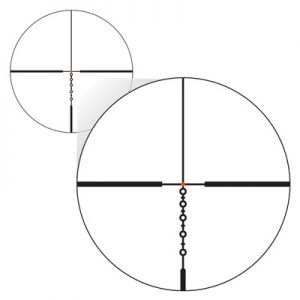
BDC Reticle: Courtesy of Nikon.com
Most BDC reticles offer to drop compensation dots out to 600 yards for a specific caliber. Those with holdover points above the center of the reticle can be used with inclined scope mounts for further increasing these BDC reference points. But that’s for pro uses.
BDC reticles are useful for hunting, combat, and also competitions. When you have to quickly switch the range.
Dot Reticles
Dot reticles gained popularity in the mid-1970s after red dot optics were widely appreciated by sporting and combat rifle enthusiasts.
Plain Dot Reticle
A plain dot reticle features only a single red (or other color) dot on the center of the reticle. This dot works as a reference point and does not offer any extra references for adjustments. These reticles are characterized by the size of the dot. Which is calculated in MOA. There are 1, 2, 3 and up to 8 MOA dot reticles available today. The number before MOA expresses the subtension of the dot at 100 yards.
These reticles are very popular for open optical sights like collimator reflex or holographic sights. The best use for them is close-range battles and competitions like 3 guns where quick acquisition is imperative.
Circle-Dot Reticle
Circle-dot reticles feature a combination of a red/green dot in the center that is encapsulated by a large circle. Both the dot and the circle have fixed subtension. The best use of such reticles is for combat where the large outer circle helps with quick acquisition and makes sure the bullet hits a generalized area. Whereas the smaller center dot is for pinpoint accuracy.
Holographic sights like the EOTech HWS use such reticles. These are mostly used by the military for close combat or competitive shooters for 3-gun competitions.
Variations of Reticles
After scouring through the basic design elements of a reticle. Let’s take a look at some extra and unique features that make a reticle suitable for specific situations.

Photo credit: gungoals.com
Illuminated Reticles
Some scopes feature reticles that can be lit up in one or multiple colors using internally fitted electronics. Any type of reticle can come in an illuminated variant. These reticles are mostly useful when shooting under very low light or unfavorable lighting conditions. Hence allowing you to view the elements of the reticle with ease.
Illuminating a reticle requires batteries. When the battery dies, the reticle will turn into a normal black reticle. Still visible in daylight. Some exceptions like the Trijicon ACOG offer dual illumination that works with and without batteries.
Glass Etched Reticles

Glass Etched Reticle - source
As the name suggests, these reticles are etched on a piece of glass through laser engraving tools. The benefit of glass etched reticles is that they are not prone to disturbances or even damage under pressure or drops. The only way to damage such a reticle is to damage the glass itself.
Glass etched reticles mostly increase the cost of scopes and are widely popular among shooters that put their rifles through harsh maneuvers and rough storage. The only drawback of this design was a menial loss in light transmission. But that has already been overcome with multi-coated glass.
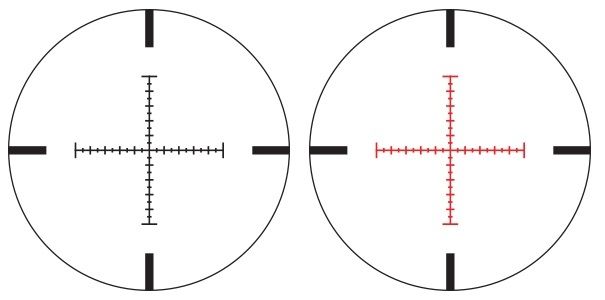
Photo credit: optics-trade.eu
Wire Reticles
The most basic method of designing reticles is to align two wires inside a circular housing and place it inside the scope tube. Wire reticles are made from thin tungsten or any other durable metal.
The shapes of reticles are pretty much limited and these reticles also can’t be made into complex designs. Since the wire is prone to misalignment or even breaking under extreme pressure circumstances.
Wire reticles are fairly tough and durable. Along with being quite inexpensive to manufacture.
Holographic Reticles
The latest advancement in scope technology is holographic reticles. These are complex electronically operated reticles that use a combination of LEDs and mirrors to project a 3D holographic image of the target.
Only EOTech manufactured holographic sights until 2017 when Vortex launched their first version. These reticles are great for quick target acquisition and focus with very little parallax error. However, they are expensive and useless without batteries.

Night Vision Reticles
These reticles are specially designed to work with night vision devices. These reticles can work with infrared light and are always illuminated. Night vision compatible reticles can also be used during the day but with a few limitations.
Due to the technology involved in their design, scopes with night vision compatibility are expensive and mostly used for tactical uses or night time hunting.
Rangefinder Reticles
These reticles are designed in such a manner that different elements help the shooter to estimate the range of a target. These reticles work at a specific magnification setting. The increments in lines are usually referenced to a set value.
For example, the size of a deer’s chest. Depending upon how many hatch marks or bars this reference occupies, the shooter can estimate the distance of the target.
Cost is not a big concern here because no extra components are required to manufacture these scopes.
Other Reticle Features to Consider
Apart from the basic design of the reticle, there are a few extra, and often useful features that should be taken into consideration. A reticle suitable for a situation may not necessarily be useful in another. So decide wisely.

Second Focal Plane or First Focal Plane?
As already discussed in a previous section. An SFP or FFP scope is an important consideration especially when you are looking at shooting 300 yards or more. Basic reticle designs like the duplex and German #1 have nothing to do with the focal plane. That only comes into play when your reticle has holdover marks for windage and elevation.
Since an FFP reticle stays true to the turret adjustments, no matter what the magnification. Long range and tactical shooters prefer FFP. Whereas hunters can choose either.
What Does the Center Look Like?
A cluttered reticle (often called a busy reticle) can have multiple dots and lines denoting factors like distance, windage, elevation, etc. It is always better to analyze what use you’ll be putting your scope up to.
Simple reticles like red dots, duplex, or mil-dots are good for hunting because you have to focus on just one target and the hit should be clear and definitive. If you don’t need too many factors to decide your shot. Better stick to non-complex designs.
Dot Size
The dot size is denoted in terms of MOA. A 1 MOA dot covers one inch of the target at 100 yards and is very fine. Larger dots cover more area as the range increases.
Smaller dots are usually chosen for precision uses where pinpoint accuracy is needed. Since the dot covers less area on the target. Larger dots like 3, 4, or even 8 MOA are good for close-quarter engagements where quick acquisition is imperative. Hence improving your chances of a hit even if your aim is fiddling a bit under stress.
Caliber Configuration
Some reticle designs like the BDC are sometimes designed to suit specific calibers and bullet grains. This makes those reticles favorable for their specific caliber right out of the box.
Calibers intended for longer ranges require more complex reticles that can provide appropriate adjustments and utter precision. Additionally, some scope manufacturers offer ballistic calculator software to tune the reticle adjustment on the field for a specific caliber.

Conclusion
Reticles are the primary interaction point that connects the shooter with the target. Reticles have undergone revolutionary changes throughout their existence and range from basic duplex designs to the most complex holographic sights. The choice of a reticle depends upon your intended applications and if you are ready to play with their mild and overly complex features.
People Also Ask
Refer to this FAQ section for any other generic or unique doubts that may come up in your mind regarding reticles.
What is a 30/30 Reticle?
It is a duplex rangefinder reticle designed by Leupold. It has been designed in such a manner that at 4x magnification, the total distance covered by the fine inner crosshairs is 30 inches at 100 yards. This reticle is used to determine the right point of impact on a target when hunting.
Are BDC Reticles Caliber Specific?
Some BDC reticles are caliber specific whereas others can be used with multiple calibers using a ballistics calculator.
How to Fix a Canted Reticle
Using a scope bubble level is always better to ensure if the reticle is canted or not. If it is, you can unscrew the eyepiece and use a toothpick or similar item to correct the cant and align it to the turrets. Plus, putting some glue around the brass ring housing the reticle. If you own a pricey scope, it’s better to contact the warranty department.
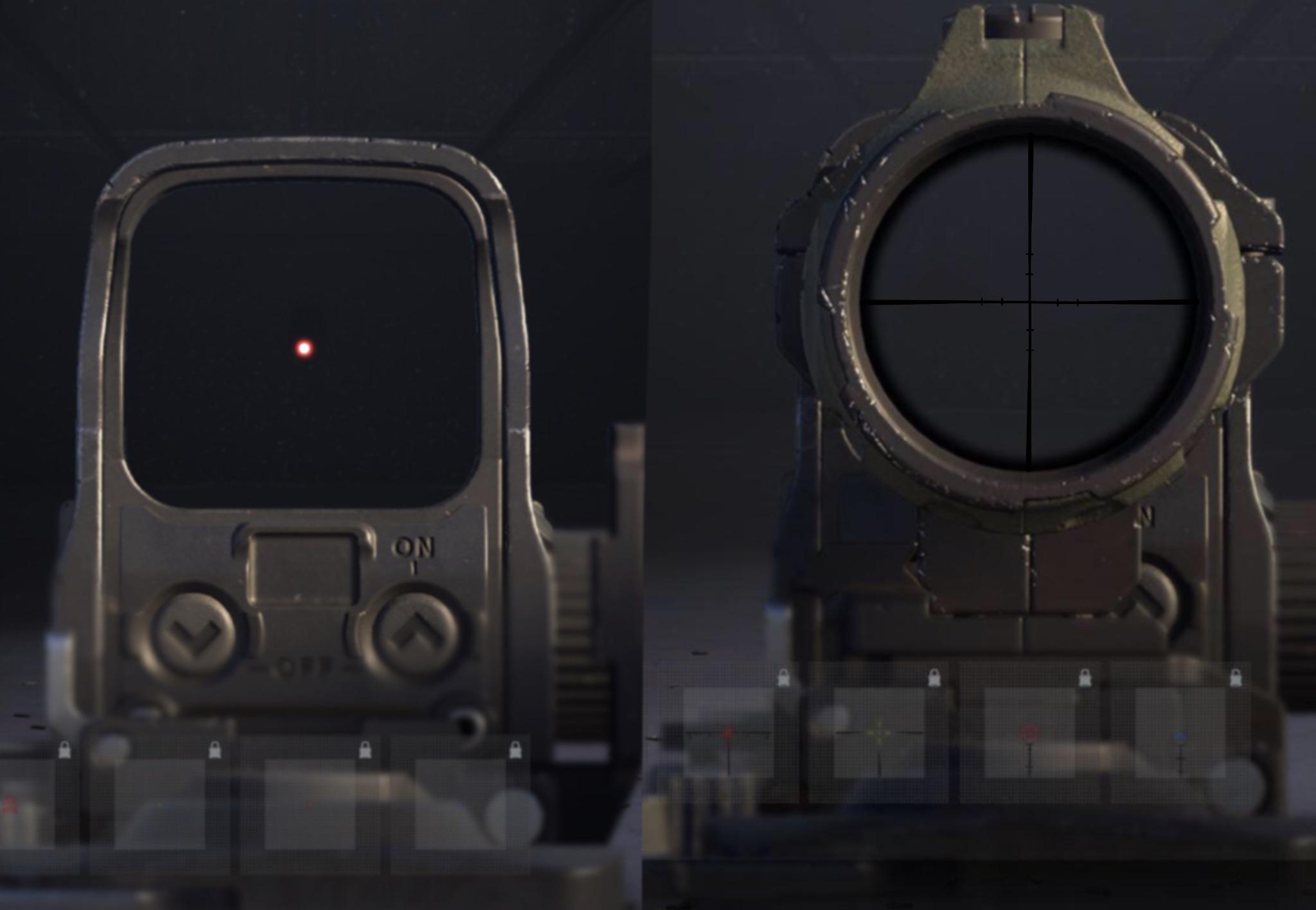
Photo credit: reddit.com
What is an ACOG Horseshoe Reticle?
The ACOG Horseshoe is a tactical reticle with quick acquisition illuminated red dot top and BDC stadia lines. These lines also denote a gap of 19 inches which is the average width of human shoulders. The base of the horseshoe is 300 meters, the center is 200 meters and the top is 100 meters. The lead dots on the sides are for tracking moving targets or shooting when moving.
What is a V Plex Reticle?
The V-Plex is Vortex’s version of the standard Duplex reticle. It is an MOA based reticle that features a bit wider and darker horizontal posts compared to the normal Duplex reticle.
What is an ACSS Reticle?
The Advanced Combat Sighting System (ACSS) reticle has been developed jointly by Primary Arms and Trijicon. It features bullet drop compensation with a range estimation system, wind and moving leads into a single setup with quick acquisition capability.

